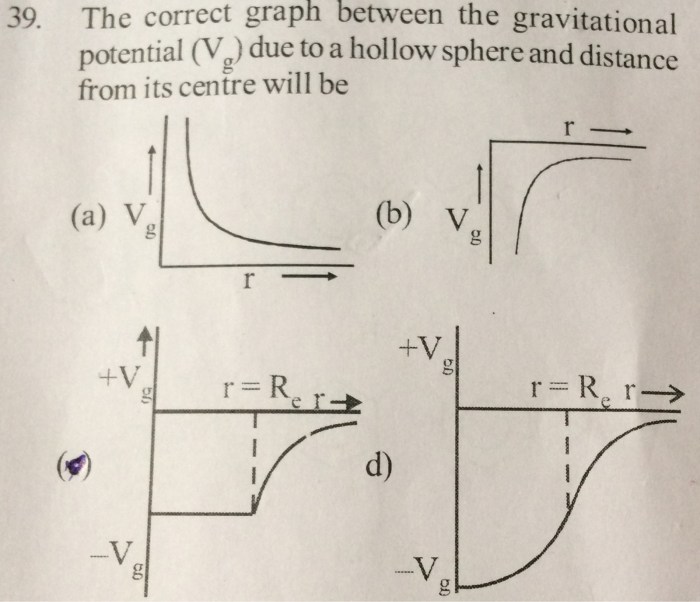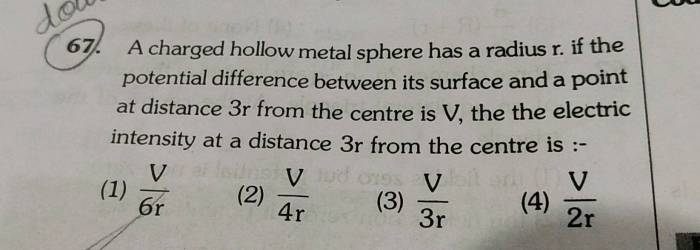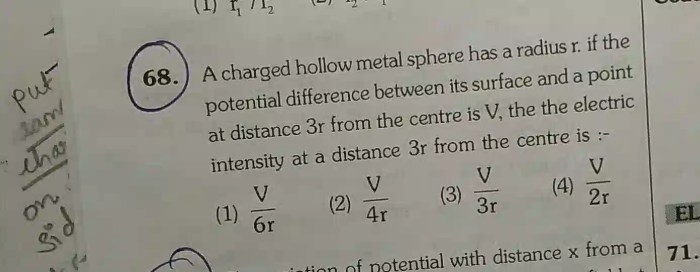A hollow metal sphere has a potential of – In the realm of electrostatics, a hollow metal sphere stands as a fascinating subject, offering insights into the interplay between charge distribution and electric potential. This exploration delves into the fundamental concepts, applications, and intricacies surrounding a hollow metal sphere’s potential, providing a comprehensive understanding of its unique characteristics and practical significance.
Electrostatic Potential and Capacitance
The electrostatic potential of a hollow metal sphere is the electric potential at a given point in space due to the presence of the charged sphere. It is a scalar quantity and is measured in volts (V). The potential at a point outside the sphere is given by:
V = k
Q / r
where:
- k is the Coulomb constant (8.988 x 10^9 N m^2/C^2)
- Q is the charge on the sphere (C)
- r is the distance from the center of the sphere to the point (m)
The potential inside a hollow metal sphere is zero, regardless of the charge on the sphere.
Charge Distribution and Field

The charges on a hollow metal sphere are distributed uniformly over its surface. This is because the electric field inside the sphere is zero, so there is no force on the charges to move.
The electric field outside the sphere is the same as that of a point charge located at the center of the sphere. This is because the charges on the surface of the sphere cancel each other out, so the only electric field is due to the charge at the center.
Applications and Uses: A Hollow Metal Sphere Has A Potential Of

Hollow metal spheres are used in a variety of applications, including:
- Faraday cages: Hollow metal spheres can be used to create Faraday cages, which are enclosures that shield their contents from electromagnetic fields.
- Electrostatic shielding: Hollow metal spheres can be used to shield sensitive equipment from electrostatic discharge (ESD).
- Capacitors: Hollow metal spheres can be used to create capacitors, which are devices that store electrical energy.
Design and Construction

When designing a hollow metal sphere, it is important to consider the following factors:
- Material properties: The material of the sphere should be a good conductor of electricity.
- Thickness: The thickness of the sphere should be sufficient to provide adequate shielding.
- Shape: The sphere should be as spherical as possible to ensure uniform charge distribution.
Hollow metal spheres can be constructed using a variety of methods, including spinning, welding, and casting.
Experimental Setup and Measurements

To measure the potential of a hollow metal sphere, the following equipment is required:
- Electrometer
- Power supply
- Connecting wires
The electrometer is connected to the sphere, and the power supply is used to charge the sphere. The electrometer will then measure the potential of the sphere.
It is important to note that the potential of a hollow metal sphere is not affected by the presence of the electrometer. This is because the electrometer is a high-impedance device, so it does not draw any current from the sphere.
Q&A
What is the significance of a hollow metal sphere’s potential?
The potential of a hollow metal sphere plays a crucial role in its ability to shield enclosed objects from external electric fields. This property finds applications in Faraday cages and electrostatic shielding, protecting sensitive equipment from electromagnetic interference.
How is the potential of a hollow metal sphere calculated?
The potential of a hollow metal sphere is determined by its radius and is given by the formula V = kQ/R, where V is the potential, k is Coulomb’s constant, Q is the total charge on the sphere, and R is the radius of the sphere.
Why is the electric field inside a hollow metal sphere zero?
The electric field inside a hollow metal sphere is zero because the charges on the sphere’s surface distribute themselves in such a way that the electric fields they create cancel each other out.